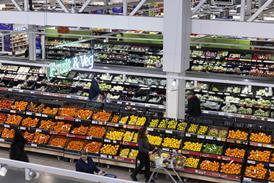Stockpiling bulky, high value returned goods in stores or RDCs to worry about later is costing retailers a small fortune, says McDonnell. And the problem is only going to get worse as white goods and electrical items become standard fixtures on supermarket shelves.
Retailers' IT and logistics systems are designed to move goods forwards. Systems for moving things in the opposite direction are either non-existent or designed to handle crates, packaging and dollies going back to RDCs  not broken hi-fi units and faulty TVs, says Consignia's warehousing and distribution general manager Richard Rogers. These need assessing, repairing, recycling, returning or selling onto the secondary market  quickly.
"Returns have traditionally been at the bottom of retailers' priority lists," says Rogers, who has set up a reverse logistics network for Safeway with US partner Return Logistics. "And this means huge delays, billing disputes, inaccurate administration and piles of stock tied up in dark corners of warehouses losing value and taking up space retailers don't have."
Safeway supply chain project manager Ian Mayhew said Safeway realised earlier than most that developing a robust returns process was essential as the non-food offer grew. Under the new system, whereby carriers collect returned goods from Safeway stores and take them to a depot in Swindon for assessment and processing, Safeway now recoups three times the amount of working capital from its returns and has significantly improved recovery levels from suppliers.
Environmental legislation
They are collected in week one, processed in week two and capital is released in week three, either through returning products to manufacturers, recycling or selling on to jobbers.
Returns handling has always been about finding a cut-off point where scrapping is cheaper than reprocessing, says Rogers. However, environmental legislation and not economics could soon determine where that cut-off point is.The cost of waste disposal is going up, and European legislation bans some products from landfill altogether, such as batteries, paints, solvents, white goods and tyres, he adds. "This has pushed reverse logistics up the agenda."
Legislation rubber stamped in Brussels this month will force producers to take responsibility for the re-use and recycling of all electronic goods at the end of their lives by 2005, and while collection will probably be contracted out to local authorities, the costs could be considerable. Under the directive, manufacturers will have to provide a financial guarantee that they will pay for recycling costs the moment a product is put on the market.
However, the clampdown on landfill is also raising tension for different reasons. Protecting your brand from being sold in the secondary market is a priority for major branded manufacturers, whose biggest fear is seeing their products resurface in a bargain bucket at a store down a side street. According to Tablogix, which handles Tesco's returns, one well known electronics manufacturer used to buy landfill sites just to prevent its rejected goods being sold back into the market.
Credit disputes can reach millions
No real research has been done to quantify how much returns are costing UK grocery retailers, but all agree the figure's high and rising, says Tablogix business development director Phil Morgan. "No one can afford to write off potentially profitable goods." If you are selling high value, short shelf life goods like electronics, speed of turnaround is critical to profitability. Likewise, if you don't have a rapid and transparent returns system in place, credit disputes with suppliers can run into millions. Delays only increase the likelihood of goods getting lost, stolen, or damaged.
Another benefit of tracking returns processing electronically is the ability to feed that information back to trading teams, adds Safeway's Mayhew. "We are starting to build an extensive database on returns so we can assess our customer offering from a business controls point of view."
No amount of information will eliminate returns, however, and supermarkets are beginning to realise that shelling out cash for providing an aftercare or repairs service for high value goods is cheaper in the long run than taking everything back. Safeway provides a customer aftercare service on own label electrical equipment and Asda is launching a TV repair service in November.
This is part of a two-pronged approach to returns, says Asda general manager for electronics, Ged Taylor. In many cases returned goods are not faulty, but customers need assistance at home. Where there is a genuine fault, the goods are taken to a 50,000 sq ft facility at Lutterworth. Here they are assessed, and then either collected by suppliers, jobbed off into the market via a third party, or refurbished, badged as reconditioned and redistributed to stores. Their progress is mapped on Retail Link, Wal-Mart's private exchange, providing visibility for interested parties such as buyers.
Although it may be cheaper to utilise your existing distribution network for handling returns, however, many retailers do not have the space or expertise to deal with them in-house, says Accenture's Sharpe. The important thing is having a system that can process your returned goods quickly and recover as much cash as possible.The smart operators are beginning to realise that moving goods backwards in the supply chain is as important as being able to move them forward.
{{ANALYSIS }}
Retailers' IT and logistics systems are designed to move goods forwards. Systems for moving things in the opposite direction are either non-existent or designed to handle crates, packaging and dollies going back to RDCs  not broken hi-fi units and faulty TVs, says Consignia's warehousing and distribution general manager Richard Rogers. These need assessing, repairing, recycling, returning or selling onto the secondary market  quickly.
"Returns have traditionally been at the bottom of retailers' priority lists," says Rogers, who has set up a reverse logistics network for Safeway with US partner Return Logistics. "And this means huge delays, billing disputes, inaccurate administration and piles of stock tied up in dark corners of warehouses losing value and taking up space retailers don't have."
Safeway supply chain project manager Ian Mayhew said Safeway realised earlier than most that developing a robust returns process was essential as the non-food offer grew. Under the new system, whereby carriers collect returned goods from Safeway stores and take them to a depot in Swindon for assessment and processing, Safeway now recoups three times the amount of working capital from its returns and has significantly improved recovery levels from suppliers.
Environmental legislation
They are collected in week one, processed in week two and capital is released in week three, either through returning products to manufacturers, recycling or selling on to jobbers.
Returns handling has always been about finding a cut-off point where scrapping is cheaper than reprocessing, says Rogers. However, environmental legislation and not economics could soon determine where that cut-off point is.The cost of waste disposal is going up, and European legislation bans some products from landfill altogether, such as batteries, paints, solvents, white goods and tyres, he adds. "This has pushed reverse logistics up the agenda."
Legislation rubber stamped in Brussels this month will force producers to take responsibility for the re-use and recycling of all electronic goods at the end of their lives by 2005, and while collection will probably be contracted out to local authorities, the costs could be considerable. Under the directive, manufacturers will have to provide a financial guarantee that they will pay for recycling costs the moment a product is put on the market.
However, the clampdown on landfill is also raising tension for different reasons. Protecting your brand from being sold in the secondary market is a priority for major branded manufacturers, whose biggest fear is seeing their products resurface in a bargain bucket at a store down a side street. According to Tablogix, which handles Tesco's returns, one well known electronics manufacturer used to buy landfill sites just to prevent its rejected goods being sold back into the market.
Credit disputes can reach millions
No real research has been done to quantify how much returns are costing UK grocery retailers, but all agree the figure's high and rising, says Tablogix business development director Phil Morgan. "No one can afford to write off potentially profitable goods." If you are selling high value, short shelf life goods like electronics, speed of turnaround is critical to profitability. Likewise, if you don't have a rapid and transparent returns system in place, credit disputes with suppliers can run into millions. Delays only increase the likelihood of goods getting lost, stolen, or damaged.
Another benefit of tracking returns processing electronically is the ability to feed that information back to trading teams, adds Safeway's Mayhew. "We are starting to build an extensive database on returns so we can assess our customer offering from a business controls point of view."
No amount of information will eliminate returns, however, and supermarkets are beginning to realise that shelling out cash for providing an aftercare or repairs service for high value goods is cheaper in the long run than taking everything back. Safeway provides a customer aftercare service on own label electrical equipment and Asda is launching a TV repair service in November.
This is part of a two-pronged approach to returns, says Asda general manager for electronics, Ged Taylor. In many cases returned goods are not faulty, but customers need assistance at home. Where there is a genuine fault, the goods are taken to a 50,000 sq ft facility at Lutterworth. Here they are assessed, and then either collected by suppliers, jobbed off into the market via a third party, or refurbished, badged as reconditioned and redistributed to stores. Their progress is mapped on Retail Link, Wal-Mart's private exchange, providing visibility for interested parties such as buyers.
Although it may be cheaper to utilise your existing distribution network for handling returns, however, many retailers do not have the space or expertise to deal with them in-house, says Accenture's Sharpe. The important thing is having a system that can process your returned goods quickly and recover as much cash as possible.The smart operators are beginning to realise that moving goods backwards in the supply chain is as important as being able to move them forward.
{{ANALYSIS }}








No comments yet